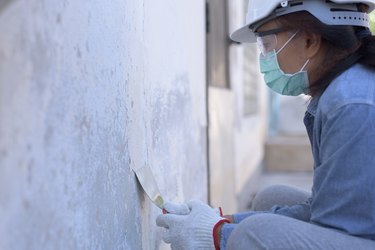
Although numerous chemicals and paint removal agents are available in hardware stores, "paint strippers" or chemicals that are used to remove paint fall under two main categories: SBS or solvent-based strippers and CBS or caustic-based strippers. The most common chemicals and solvents used to remove paint include methylene chloride, acetone, toluene, methanol, N-methyl-pyrrolidone, sodium hydroxide and ammonia hydroxide. Other paint removing chemical solvents include isopropyl alcohol, acetone, lacquer thinner and epoxy. When selecting a paint stripper, evaluate both the effectiveness and safety of each option.
Caustic Paint Removal Chemicals
Video of the Day
This category of paint removal chemicals consists mainly of sodium hydroxide. Considered environmentally friendly and non-toxic, these paint removers take anywhere from 12 to 42 hours to work. They effectively remove a wide range of paint coatings, including older (calcimine paints and milk) and newer finishes. They cannot be used to remove paint from galvanized steel, magnesium stainless or aluminum.
Video of the Day
Because of its relatively slow response time, this group of chemicals is used as a last resort to remove stubborn paint.
Toluenelmethanol for Paint Removal
This category of chemicals effectively removes varnishes, lacquer and shellac. These chemicals work well to remove newer paint, but are not as effective against the older coatings. Their main drawback is their flammability, making their use a potential hazard. One spark is all it takes to cause a fire. Toluenelmethanol chemicals are used scarcely and only in controlled environments.
Remove Paint with Methylene Chloride
Methylene chloride (MC) is the backbone of the paint removal industry. It effectively delaminates layers of paint instead of liquefying them, as other chemicals typically do. Methylene chloride-based paint removal agents, or solvent-based paint strippers, are available in gel and liquid form, with the gel version used as the primary paint removal and the liquid as the final wash.
The major and significant drawback of methylene chloride is its health risks. The U.S. Consumer Product Safety Commission has formally classified it as a carcinogen and the Environmental Protection Agency (EPA) has classified it as a hazardous air pollutant.
N-Methyl-Pyrrolidone Paint Remover
This group of paint removing chemicals was introduced to address the disadvantages and health hazards of existing paint stripping chemicals available. However, solvent-based paint strippers containing N-Methyl-Pyrrolidone (NMP) are not without risk. NMP is classified by the EPA as a developmental toxicant and may cause miscarriages.
Paint removals based on NMP are effective in stripping surfaces from old, stubborn paints, as they are excellent in removing multiple layers of paint. Their major drawback is their price, which is approximately three to five times that of other paint removal agents. In addition, they are slow to take effect. It can take anywhere from 12 hours to an entire week to remove paint, although initial effects are visible within the first 24 hours.
Acetone, Methanol and Toluene
This group of chemicals is typically bunched together to remove paint. This highly flammable group effectively dissolves paint from the top layer down. This least expensive paint removing mixture should be avoided in closed spaces or those with poor ventilation.